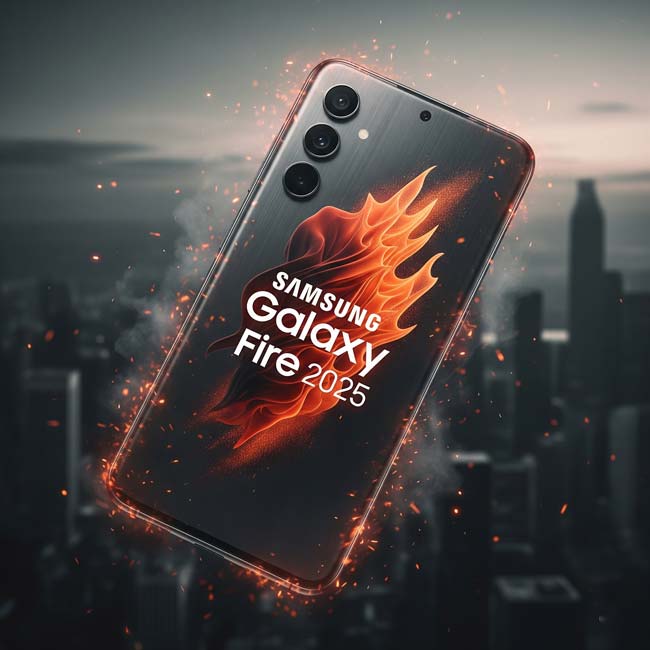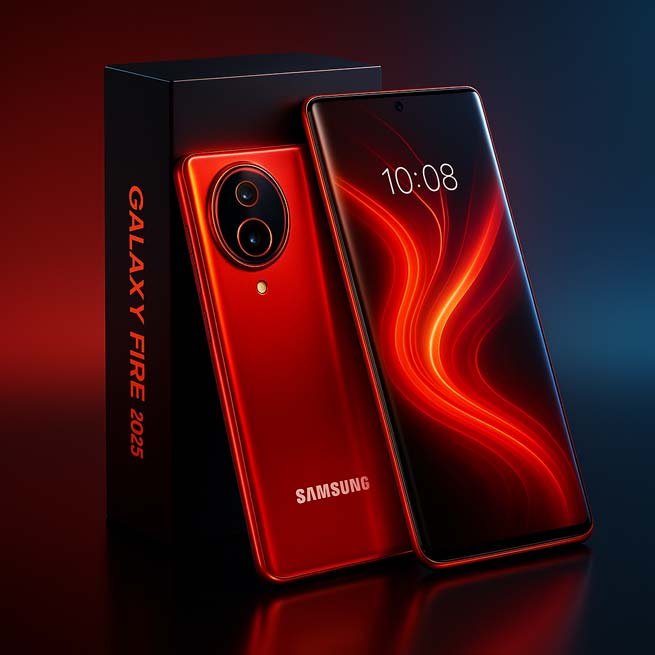Discover the Samsung Galaxy Fire 2025 concept: expected specs, camera features, battery, price, release. Samsung Galaxy Fire 2025 (Concept): Red-Hot Specs, Price, Release Window & Everything We Expect
Editor’s note: “Galaxy Fire 2025” is an unannounced/rumored concept. Details below are based on industry chatter and educated projections—not official specs.
Concept render of the Samsung Galaxy Fire 2025 in a bold red finish.
The rumored Samsung Galaxy Fire 2025 aims to light up Samsung’s lineup with a performance-first identity, aggressive design, and a battery built for marathon sessions. Think of it as a fan-favorite blend: clean software, flagship silicon, a gaming-ready display, and cameras that don’t crumble after dark. If Samsung brings this concept to market, here’s what a realistic, buyer-friendly package could look like.
Contents
Key highlights (expected)
- 6.78-inch LTPO AMOLED with 1–120Hz variable refresh and QHD+ sharpness
- Next-gen 4nm flagship chipset with desktop-class GPU and on-device AI acceleration
- 12–20GB LPDDR5X RAM, up to 1TB UFS 4.0 storage
- Triple camera with large main sensor + OIS, improved night mode, and dedicated Pro Video tools
- 5,500–6,000mAh battery with fast wired/wireless charging and smart thermal control
- Android 15 with One UI, extended security updates, and AI features like live translate & scene optimization
- IP68 body, Gorilla Glass protection, aluminum frame in striking “Fire Red” finish
- Wi-Fi 7, Bluetooth 5.4, dual-SIM/eSIM, 5G (sub-6 + region-dependent mmWave)
Expected specifications of Samsung Galaxy Fire 2025 (subject to change)
| Category | Details (rumored) |
|---|---|
| Display | 6.78″ LTPO AMOLED, QHD+ (~3200×1440), 1–120Hz, up to 2,600 nits peak |
| Chipset | Next-gen 4nm flagship (Snapdragon/Exynos depending on region) |
| Memory | 12/16/20GB LPDDR5X |
| Storage | 256GB/512GB/1TB UFS 4.0 |
| Rear Cameras | 50MP main (large sensor, OIS) + 12MP ultra-wide + 10MP 3–5× telephoto with OIS |
| Front Camera | 32MP with 4K video, Night Selfie, advanced HDR |
| Battery | 5,500–6,000mAh; fast wired (≥65W) + fast wireless |
| Software | Android 15 + One UI; multi-year OS and security updates |
| Build | Aluminum frame, Gorilla Glass, IP68 water/dust resistance |
| Audio | Stereo speakers with spatial tuning; high-impedance DAC support via USB-C |
| Biometrics | Ultrasonic in-display fingerprint, face unlock |
| Connectivity | 5G (sub-6 + mmWave in select markets), Wi-Fi 7, BT 5.4, NFC, USB-C (USB 3.x) |
Design & build: why “Fire” stands out
The “Fire” moniker suggests a distinct identity: vibrant red accents, smoky gradient glass, and crisp, flat sides for an ergonomic yet premium hand feel. Expect tiny bezels, symmetrical lines, and a rear camera island that emphasizes function over gimmicks—clean rings, anti-glare coating, and stronger scratch resistance. Samsung’s IP68 seal means spills, rain, and dusty trails won’t end your day.

Display: fluid, bright, and battery-smart
A top-tier LTPO AMOLED panel is near certain. It should ramp from 1Hz for static content to 120Hz when you scroll or game, then drop again to save power. QHD+ resolution keeps text razor-sharp, while an advertised 2,000+ nits helps with direct sunlight. Expect color profiles (Vivid/Neutral), Vision Booster for outdoor contrast, and hardware-level PWM dimming that’s easier on the eyes.
Performance & software: built for speed, tuned for longevity
Under the hood, the Galaxy Fire 2025 should use a next-gen 4nm flagship SoC with a punchy GPU and an upgraded NPU for on-device AI. Paired with up to 20GB RAM and UFS 4.0 storage, everything from opening apps to exporting 4K video should feel instantaneous. One UI on Android 15 brings polished multitasking, granular privacy controls, and quality-of-life perks like Quick Share, Modes & Routines, and seamless clipboard sync across devices.

Samsung has leaned into long software support on recent flagships; expect a competitive promise here too, along with frequent security patches that keep your data safer for years.
Cameras: bright nights, steady video
The rumored camera setup balances everyday usability with creator-friendly tools. The large main sensor with OIS captures more light, improving color consistency and dynamic range at night. The ultra-wide lens keeps distortion low for architecture and group shots, while a dedicated telephoto with OIS preserves detail at 3–5× optical zoom—no noisy crops.
- Nightography 2.0 (expected): multi-frame processing and AI denoise for clearer low-light shots.
- Pro Video: manual ISO/shutter, LOG-style profiles, and a horizon lock for action sequences.
- Portrait Engine: layered depth mapping for truer subject separation and hair-edge detail.
- Selfie upgrades: better skin tones and a smarter beauty slider that doesn’t blur faces.
Battery & charging: long-haul endurance
With a target capacity between 5,500 and 6,000mAh, the Galaxy Fire could push well past a day of mixed use. An adaptive battery engine learns your schedule, throttling background refresh for apps you rarely open and unlocking higher performance when you game or record video. Fast wired charging (≥65W) and quick wireless cut down top-ups, while a cooling-aware algorithm reduces heat during turbo sessions to protect battery health.
Gaming & cooling: frame rates without the burn
The “Fire” identity also points to smarter thermal design. Expect a larger vapor chamber, graphite layers, and a heat-spread frame that pulls warmth away from your hands. Paired with an adaptive GPU driver and game mode toggles, you should see more stable frame rates, reduced touch latency, and less color shift from panel heating. Haptic feedback becomes crisper, too, thanks to a tuned linear motor.
Connectivity & extras
- Wi-Fi 7 for lower latency and multi-link aggregation on supported routers
- 5G sub-6 everywhere; mmWave likely in select markets and carriers
- USB-C (USB 3.x) with faster wired data and display out
- Secure unlock: ultrasonic fingerprint + improved face unlock
- Samsung ecosystem: DeX, SmartThings, Find, and Galaxy Buds auto-switch
Expected price & release window
Positioning looks premium. A realistic starting tag is $899–$1,099 in the U.S., with higher tiers for 512GB/1TB storage. Launch timing would likely fall in 2025 with regional rollouts influenced by carrier certification. As always, final pricing, colors, and bundles (charger included or not) will be clear only at announcement.

Who the Galaxy Fire 2025 is for
If you crave long battery life, a bright, fast screen, and cameras that don’t buckle at night, the Fire concept hits the sweet spot. It’s for gamers, creators, and heavy multitaskers who want top-tier performance without abandoning refined design. If you prioritize compact size or a budget tag, you may prefer Samsung’s smaller or mid-range lines—but keep an eye on this one if endurance and speed top your list.
Pros & cons (based on expectations)
Pros
- Flagship-class performance with generous RAM/storage options
- LTPO AMOLED: smooth 120Hz and battery-efficient 1Hz idle
- Big battery with fast wired/wireless charging
- Versatile cameras with improved night and telephoto
- IP68 build, Gorilla Glass, and long software support
Cons
- Premium pricing likely
- Large footprint may not suit small-phone fans
- mmWave and chipset variants may vary by region
- Charger in box uncertain
Frequently asked questions
Is the Samsung Galaxy Fire 2025 confirmed?
No. It’s a concept/rumored device. Specs and timelines here are expectations until Samsung announces it.
What are the expected specs?
Think 6.78″ LTPO AMOLED at 1–120Hz, a next-gen 4nm flagship chip, up to 20GB RAM, up to 1TB storage, triple cameras with OIS, and a 5,500–6,000mAh battery with fast charging.
How much could the Galaxy Fire 2025 cost?
A reasonable bracket is $899–$1,099 for the base tier, rising with storage and regional taxes.
Does it support DeX and advanced ecosystem features?
Samsung typically offers DeX, SmartThings, and Galaxy device continuity on premium phones, so we expect similar support here.
Will it get long software support?
Recent Samsung flagships ship with extended OS and security updates. Expect a comparable policy, to be confirmed at launch.
When will it be released?
A 2025 window is likely, with availability varying by region and carrier certification.




















